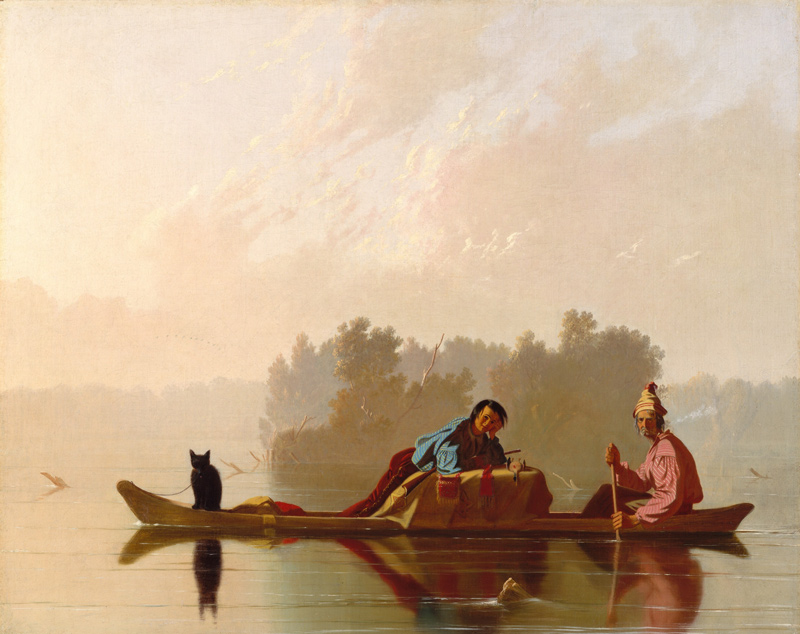Fur Traders Descending the Missouri (1845)
by George Caleb Bingham (1811–1879)
Courtesy Metropolitan Museum of Art, Morris K. Jesup Fund, 1933. Licensed under the Creative Commons CC0 1.0 Universal Public Domain Dedication.
Originally titled “French Trader & Half breed Son,” this painting idealized life on the Western frontier for an appreciative Eastern audience. [1]The Met, www.metmuseum.org/art/collection/search/10159 accessed 3 January 2023.
(ca. 1780—1807)
No one knows for sure whether this French boatman truly was named La Liberté, a common surname in Louisiana, or whether this name was the type of cognomen called a “dit name,” which also was common among the French.
We do know that the name La Liberté was not on the captains’ original list of expedition engagés, or hired hands. He could have been hired later, on the Missouri River, or appear on the list under his baptismal name. La Liberté apparently had been up the Missouri into Otoe country before, and spoke that language.
Late in July 1804, the Corps knew, probably from Labiche who previously had traded with the Otoes, that they were in Otoe country. Around today’s Omaha, Nebraska, Clark wrote about seeing “mounds” where Otoe people had once lived. On the 28th, George Drouillard returned from hunting accompanied by a Missouri man, who said his people and Otoes were bison-hunting four miles away. The next day, the captains sent La Liberté with the Indian man to invite chiefs to meet them farther north on the Missouri River for a council. The Frenchman rode one of the expedition’s two horses.
And that was the last most of the men ever saw of La Liberté. He apparently was done with the exploration after about two and half months—or less.
The Indians arrived at the designated meeting place on 3 August 1804, and when La Liberté was not with them, Clark at first assumed that he had either “tired his horse or, lost himself in the Plains[.] Some Indians are to hunt for him . . .” Then Pvt. Moses Reed left three days later, supposedly to retrieve his knife, but a search of his pack indicated he had deserted. Lewis and Clark sent four men back downstream to look for Reed, and added La Liberté to the order. On 7 August 1804, Drouillard, Reubin Field, William Bratton, and François Labiche headed town the back trail.
Late on the afternoon of 17 August 1804, Labiche caught up with the Corps and reported that his group had caught La Liberté, “but he decived them and got away” (Clark). The men who sent Labiche ahead soon arrived escorting Reed, and also bringing along several Otoes and Missouris.[2]During the council, the Otoes asked to hire Labiche away from the Corps, but were refused. Gary Moulton suggests that the Otoes may have known Labiche from previous years. Moulton, ed., Journals, … Continue reading
Reed’s court-martial and punishment were held promptly, but the captains did nothing more about La Liberté, who had succeeded in his escape.
Notes
| ↑1 | The Met, www.metmuseum.org/art/collection/search/10159 accessed 3 January 2023. |
|---|---|
| ↑2 | During the council, the Otoes asked to hire Labiche away from the Corps, but were refused. Gary Moulton suggests that the Otoes may have known Labiche from previous years. Moulton, ed., Journals, 2:494n8. |
Experience the Lewis and Clark Trail
The Lewis and Clark Trail Experience—our sister site at lewisandclark.travel—connects the world to people and places on the Lewis and Clark Trail.
Discover More
- The Lewis and Clark Expedition: Day by Day by Gary E. Moulton (University of Nebraska Press, 2018). The story in prose, 14 May 1804–23 September 1806.
- The Lewis and Clark Journals: An American Epic of Discovery (abridged) by Gary E. Moulton (University of Nebraska Press, 2003). Selected journal excerpts, 14 May 1804–23 September 1806.
- The Lewis and Clark Journals. by Gary E. Moulton (University of Nebraska Press, 1983–2001). The complete story in 13 volumes.


